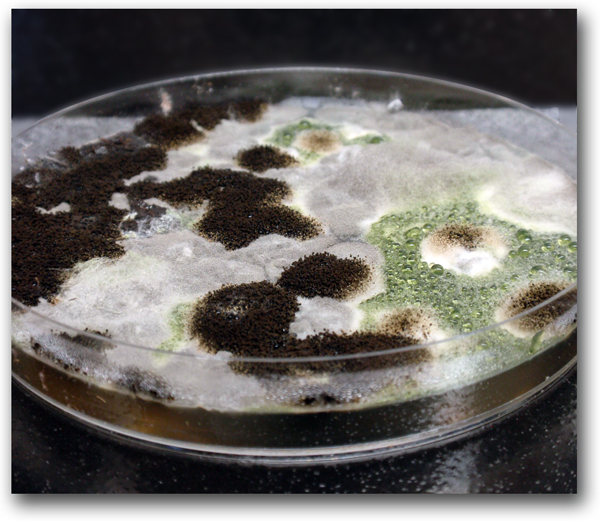The ASTM G 21 method, titled “Standard Practice for Determining Resistance of Synthetic Polymeric Materials to Fungi” is designed to test the resistance of synthetic polymeric materials (molded materials, surface treated articles or similar objects) to fungal attack.

It is a popular method, used by industry to evaluate the resistance of materials to fungal attack prior to releasing the materials for sale. It involves a diverse array of fungi sprayed onto test and control surfaces in a standardized fashion. After inoculation, surfaces are incubated for 28 days and evaluated for fungal growth.
Summary of the ASTM G 21 Test
- Fungi are grown on solid medium and a spore suspension is prepared from each following fungal genus (requisite species listed in the official method):
- Penicillium
- Aspergillus
- Chaetomium
- Trichoderma
- Aureobasidium
- Spore suspensions are washed several times and eluted in a minimal salt solution.
- The concentration of test spores are standardized and an equal volume of all five spore preparations are pooled.
- Test samples are placed, in triplicate, into Petri dishes (or other appropriately sized container) filled with minimal salts agar
- A small volume of the pooled spore preparation is sprayed directly onto the test samples. This step is repeated for the positive control (fungal growth control) and negative control (agar only).
- All Petri dishes, or containers, are sealed to maintain sufficient humidity and incubated for up to 28 days.
- Photographs are taken of each sample at regular intervals. Samples are given a performance score based on fungal growth after 28 days.
Strengths of ASTM G 21
- This test challenges materials with a wide variety of fungal species, ranging from common environmental fungi to agricultural pathogens and even antibacterial compound producing fungi, all of which have different growth requirements and enzymatic properties.
- The method and parameters are designed so that every condition for growth is present (i.e., salts, minerals, water and a humid environment) other than a sufficient carbon and/or sugar source, thus testing a materials true ability to withstand fungal attack. The initial spore concentration is relatively high, thus providing a critical challenge to synthetic materials.
Weaknesses of ASTM G 21
- Scoring can be subjective based on the observer’s interpretation of the method’s scoring pattern and that of the actual results.
- The results may not directly demonstrate a samples true capability if the spore suspension was not prepared properly and traces of growth media are present in the final spore suspensions, thus allowing fungi to grow even in the presence of samples lacking sufficient growth properties.
ASTM G 21 is an excellent choice for product developers interested in evaluating fungal resistance, and we take great care at Microchem Laboratory to make sure that the testing is done well.
